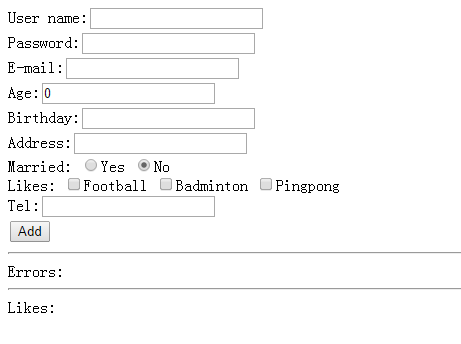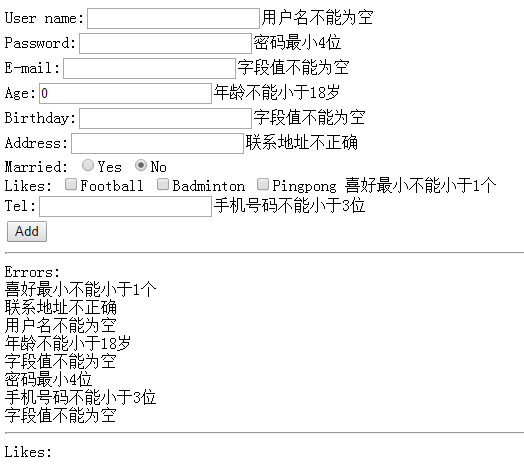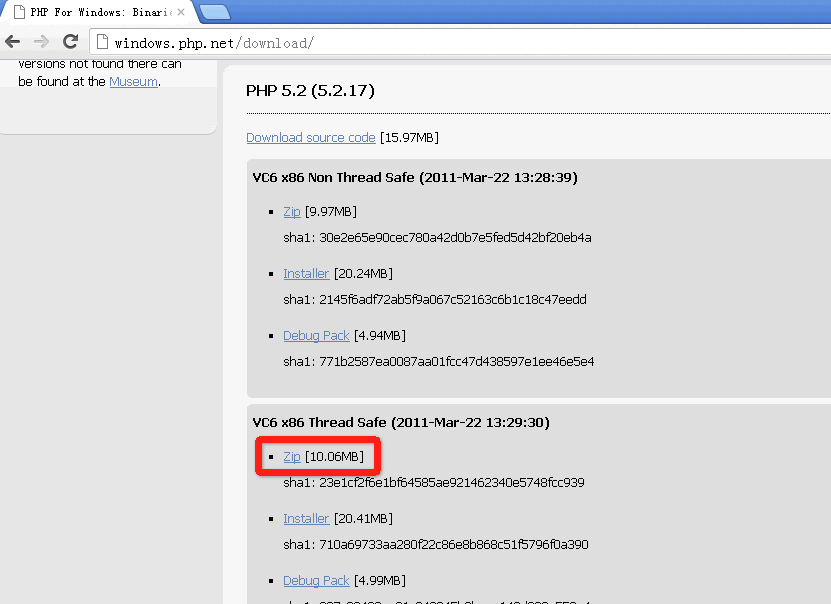简介说明
使用spring mvc的annotation验证可以直接对view model的简单数据验证,注意,这里是简单的,如果model的数据验证需要有一些比较复杂的业务逻辑性在里头,只是使用annotation做验证是比较难的。
以下是使用spring mvc自带的annotation验证,加上自定义的一个@tel的annotation验证例子,此例子具有:
1、支持多语言(国际化)
2、对默认数据先进行转化,比如int、date类型如果传入空值时,会抛异常,默认给定值
先看配置:
1、web.xml
|
1
2
3
4
5
6
7
8
9
10
11
12
13
14
15
16
17
18
19
20
21
22
23
24
25
26
27
28
29
30
31
32
33
|
<?xml version="1.0" encoding="utf-8"?>
<web-app version="3.0" xmlns="http://java.sun.com/xml/ns/javaee"
xmlns:xsi="http://www.w3.org/2001/xmlschema-instance"
xsi:schemalocation="http://java.sun.com/xml/ns/javaee
http://java.sun.com/xml/ns/javaee/web-app_3_0.xsd">
<display-name>test spring mvc - 1</display-name>
<context-param>
<param-name>contextconfiglocation</param-name>
<param-value>classpath:spring.xml</param-value>
</context-param>
<servlet>
<servlet-name>dispatcher</servlet-name>
<servlet-class>org.springframework.web.servlet.dispatcherservlet</servlet-class>
<init-param>
<param-name>contextconfiglocation</param-name>
<param-value></param-value>
</init-param>
<load-on-startup>1</load-on-startup>
</servlet>
<servlet-mapping>
<servlet-name>dispatcher</servlet-name>
<url-pattern>/</url-pattern>
</servlet-mapping>
<listener>
<listener-class>org.springframework.web.context.contextloaderlistener</listener-class>
</listener>
<welcome-file-list>
<welcome-file>index.jsp</welcome-file>
</welcome-file-list>
</web-app>
|
这里没什么好说的,只是把spring.xml配置加入到contextconfiglocation中
2、spring.xml
|
1
2
3
4
5
6
7
8
9
10
11
12
13
14
15
16
17
18
19
20
21
22
23
24
25
26
27
28
29
30
31
32
33
34
35
36
37
38
39
40
41
42
43
44
45
46
47
48
49
50
51
52
53
54
55
|
<?xml version="1.0" encoding="utf-8"?>
<beans
xmlns="http://www.springframework.org/schema/beans"
xmlns:xsi="http://www.w3.org/2001/xmlschema-instance"
xmlns:tx="http://www.springframework.org/schema/tx"
xmlns:context="http://www.springframework.org/schema/context"
xmlns:mvc="http://www.springframework.org/schema/mvc"
xsi:schemalocation="http://www.springframework.org/schema/beans
http://www.springframework.org/schema/beans/spring-beans-3.0.xsd
http://www.springframework.org/schema/tx
http://www.springframework.org/schema/tx/spring-tx-3.0.xsd
http://www.springframework.org/schema/context
http://www.springframework.org/schema/context/spring-context-3.0.xsd
http://www.springframework.org/schema/mvc
http://www.springframework.org/schema/mvc/spring-mvc-3.0.xsd">
<!--注解说明 -->
<context:annotation-config />
<!-- 默认的注解映射的支持 -->
<mvc:annotation-driven validator="validator" conversion-service="conversionservice" />
<!-- 把标记了@controller注解的类转换为bean -->
<context:component-scan base-package="com.my" />
<!-- 视图解释类 -->
<bean class="org.springframework.web.servlet.view.internalresourceviewresolver">
<property name="prefix" value="/web-inf/views/"/>
<property name="suffix" value=".jsp"/><!--可为空,方便实现自已的依据扩展名来选择视图解释类的逻辑 -->
<property name="viewclass" value="org.springframework.web.servlet.view.jstlview" />
</bean>
<!-- 资源文件:messages.properties -->
<bean id="messagesource" class="org.springframework.context.support.resourcebundlemessagesource">
<property name="basenames">
<list>
<value>messages</value>
</list>
</property>
</bean>
<!-- 验证器 -->
<bean id="validator" class="org.springframework.validation.beanvalidation.localvalidatorfactorybean">
<property name="validationmessagesource" ref="messagesource"/>
</bean>
<!-- 自定义数据类型转换器 -->
<bean id="conversionservice" class="org.springframework.format.support.formattingconversionservicefactorybean">
<property name="converters">
<list>
<bean class="com.my.controller.converter.intconverter" />
<bean class="com.my.controller.converter.dateconverter" />
</list>
</property>
</bean>
</beans>
|
在<mvc:annotation-driven/>中加入conversion-service,然后在conversion-service中加入系统默认的转换器,如上有intconverter和dateconverter,当然,也可以是自定的别的类型,这是全局的。
在validator验证器中加入了支持多语言的properties,当然,spring的多语言是基于http header的accept-language。
3、controller
|
1
2
3
4
5
6
7
8
9
10
11
12
13
14
15
16
17
18
19
20
21
22
23
24
25
26
27
28
29
30
31
32
33
34
35
36
37
38
39
|
package com.my.controller;
import java.util.list;
import javax.validation.valid;
import org.springframework.stereotype.controller;
import org.springframework.validation.bindingresult;
import org.springframework.validation.fielderror;
import org.springframework.web.bind.annotation.modelattribute;
import org.springframework.web.bind.annotation.requestmapping;
import org.springframework.web.bind.annotation.requestmethod;
import org.springframework.web.servlet.modelandview;
import com.my.controller.bean.user4;
@controller
@requestmapping(value="av")
public class testannotationvalidcontroller {
@requestmapping
public modelandview index() {
modelandview view = new modelandview("/testannotationvalid/index", "user4", new user4());
return view;
}
@requestmapping(value="/add", method=requestmethod.post)
public modelandview add(@modelattribute @valid user4 user, bindingresult result) {
modelandview view = new modelandview("/testannotationvalid/index");
view.addobject("user4", user);
if(result.haserrors()) {
list<fielderror> errors = result.getfielderrors();
for(fielderror err : errors) {
system.out.println("objectname:" + err.getobjectname() + "\\tfieldname:" + err.getfield()
+ "\\tfieldvalue:" + err.getrejectedvalue() + "\\tmessage:" + err.getdefaultmessage() + "\\tcode:");
}
}
return view;
}
}
|
这是一个简单的controller,在add中,有一个@valid的annotation,这是必需的,不加这个,annotation验证将不起作用
4、user4.java model实体类
|
1
2
3
4
5
6
7
8
9
10
11
12
13
14
15
16
17
18
19
20
21
22
23
24
25
26
27
28
29
30
31
32
33
34
35
36
37
38
39
40
41
42
43
44
45
46
47
48
49
50
51
52
53
54
55
56
57
58
59
60
61
62
63
64
65
66
67
68
69
70
71
72
73
74
75
76
77
78
79
80
81
82
83
84
85
86
87
88
89
90
91
92
93
94
95
96
97
98
99
100
101
102
103
104
105
106
|
package com.my.controller.bean;
import java.util.date;
import javax.validation.constraints.max;
import javax.validation.constraints.min;
import javax.validation.constraints.notnull;
import javax.validation.constraints.past;
import javax.validation.constraints.pattern;
import javax.validation.constraints.size;
import org.hibernate.validator.constraints.email;
import org.hibernate.validator.constraints.length;
import org.hibernate.validator.constraints.notblank;
public class user4 {
private long id;
@notblank(message="{valid.name}")
private string name;
@length(min=4, max=20, message="{valid.password}")
private string password;
@notblank(message="{valid.required}")
@email(message="{valid.email}")
private string email;
@notnull(message="{valid.required}")
private boolean married;
@min(value=18, message="{valid.agemin}")
@max(value=100, message="{valid.agemax}")
private int age;
@notnull(message="{valid.required}")
@past(message="{valid.birthday}")
private date birthday;
@pattern(regexp="^[a-za-z]{2,}$", message="{valid.address}")
private string address;
@size(min=1, message="{valid.likesmin}")
private string[] likes;
@com.my.controller.validator.tel(message="{valid.tel}", min=3)
private string tel;
public long getid() {
return id;
}
public void setid(long id) {
this.id = id;
}
public string getname() {
return name;
}
public void setname(string name) {
this.name = name;
}
public string getpassword() {
return password;
}
public void setpassword(string password) {
this.password = password;
}
public string getemail() {
return email;
}
public void setemail(string email) {
this.email = email;
}
public boolean ismarried() {
return married;
}
public void setmarried(boolean married) {
this.married = married;
}
public int getage() {
return age;
}
public void setage(int age) {
this.age = age;
}
public date getbirthday() {
return birthday;
}
public void setbirthday(date birthday) {
this.birthday = birthday;
}
public string getaddress() {
return address;
}
public void setaddress(string address) {
this.address = address;
}
public string[] getlikes() {
return likes;
}
public void setlikes(string[] likes) {
this.likes = likes;
}
public string gettel() {
return tel;
}
public void settel(string tel) {
this.tel = tel;
}
}
|
除了@tel之外,其它都是spring自带的annotation,当然还有别的,自行搜索下
5、message.properties
|
1
2
3
4
5
6
7
8
9
10
|
valid.required=字段值不能为空
valid.name=用户名不能为空
valid.password=密码最小4位
valid.agemin=年龄不能小于{1}岁
valid.agemax=年龄不能大于{1}岁
valid.email=邮箱格式不正确
valid.address=联系地址不正确
valid.birthday=生日不能大于今天
valid.likesmin=喜好最小不能小于1个
valid.tel=手机号码不能小于{min}位
|
对应的是user4 model的annotation的message值。如果需要国际化的多语言,只需要加入多一个messages_en_us.properties这样名字的文件即可。
6、@tel
|
1
2
3
4
5
6
7
8
9
10
11
12
13
14
15
16
|
package com.my.controller.validator;
import java.lang.annotation.elementtype;
import java.lang.annotation.retention;
import java.lang.annotation.retentionpolicy;
import java.lang.annotation.target;
import javax.validation.constraint;
import javax.validation.payload;
@target({elementtype.field, elementtype.method})
@retention(retentionpolicy.runtime)
@constraint(validatedby=telvalidator.class)
public @interface tel {
int min() default 0;
string message();
class<?>[] groups() default {};
class<? extends payload>[] payload() default {};
}
|
新建一个interface,注意,annotation的interface java是这样写的:@interface
telvalidator:
|
1
2
3
4
5
6
7
8
9
10
11
12
13
14
15
16
17
18
19
20
21
22
23
24
25
26
27
28
29
30
31
32
|
package com.my.controller.validator;
import javax.annotation.resource;
import javax.validation.constraintvalidator;
import javax.validation.constraintvalidatorcontext;
import org.springframework.context.support.resourcebundlemessagesource;
public class telvalidator implements constraintvalidator<tel, string> {
@resource
private resourcebundlemessagesource messagesource;
private tel tel;
@override
public void initialize(tel tel) {
this.tel = tel;
}
@override
public boolean isvalid(string value, constraintvalidatorcontext constraintcontext) {
boolean isvalid;
if(value != null && value.length() >= tel.min()) {
isvalid = true;
}
else {
isvalid = false;
}
if(!isvalid) {
constraintcontext.disabledefaultconstraintviolation();
constraintcontext.buildconstraintviolationwithtemplate(tel.message()).addconstraintviolation();
}
return isvalid;
}
}
|
这是@tel的验证实现方法。
7、converter
|
1
2
3
4
5
6
7
8
9
10
11
12
13
14
15
16
17
|
package com.my.controller.converter;
import org.springframework.core.convert.converter.converter;
public class intconverter implements converter<string, integer> {
@override
public integer convert(string text) {
if (text == null || "".equals(text)) {
return 0;
} else {
try {
integer value = integer.parseint(text);
return value;
} catch (exception e) {
return 0;
}
}
}
}
|
|
1
2
3
4
5
6
7
8
9
10
11
12
13
14
15
16
17
18
19
20
|
package com.my.controller.converter;
import java.text.parseexception;
import java.text.simpledateformat;
import java.util.date;
import org.springframework.core.convert.converter.converter;
public class dateconverter implements converter<string, date> {
@override
public date convert(string text) {
simpledateformat dateformat = new simpledateformat("yyyy-mm-dd");
dateformat.setlenient(false);
try {
return dateformat.parse(text);
} catch (parseexception e) {
e.printstacktrace();
}
return null;
}
}
|
这两个是全局的类型默认转换器。
8、测试jsp
|
1
2
3
4
5
6
7
8
9
10
11
12
13
14
15
16
17
18
19
20
21
22
23
24
25
26
27
28
29
30
31
32
33
34
35
36
37
38
|
<%@ page language="java" contenttype="text/html; charset=utf-8" pageencoding="utf-8"%>
<%@ taglib uri="http://java.sun.com/jsp/jstl/core" prefix="c" %>
<%@ taglib uri="http://java.sun.com/jsp/jstl/fmt" prefix="fmt"%>
<%@ taglib uri="http://java.sun.com/jsp/jstl/functions" prefix="fn" %>
<%@ taglib prefix="st" uri="http://www.springframework.org/tags" %>
<%@ taglib prefix="sf" uri="http://www.springframework.org/tags/form"%>
<!doctype html public "-//w3c//dtd html 4.01 transitional//en" "http://www.w3.org/tr/html4/loose.dtd">
<html>
<head>
<meta http-equiv="content-type" content="text/html; charset=utf-8">
<title>index</title>
</head>
<body>
<sf:form action="${pagecontext.request.contextpath}/av/add" method="post" modelattribute="user4">
user name:<sf:input path="name"/><sf:errors path="name" /><br/>
password:<sf:input path="password"/><sf:errors path="password" /><br/>
e-mail:<sf:input path="email"/><sf:errors path="email" /><br/>
age:<sf:input path="age"/><sf:errors path="age" /><br/>
birthday:<sf:input path="birthday"/><sf:errors path="birthday" /><br/>
address:<sf:input path="address"/><sf:errors path="address" /><br/>
married:
<sf:radiobutton path="married" label="yes" value="true"/>
<sf:radiobutton path="married" label="no" value="false"/>
<sf:errors path="married" /><br/>
likes:
<sf:checkbox path="likes" label="football" value="football"/>
<sf:checkbox path="likes" label="badminton" value="badminton"/>
<sf:checkbox path="likes" label="pingpong" value="pingpong"/>
<sf:errors path="likes" /><br/>
tel:<sf:input path="tel"/><sf:errors path="tel" /><br/>
<input type="submit" value="add" />
<hr/>
errors:<br/><sf:errors path="*"></sf:errors>
<hr/>
likes:<c:foreach items="${user4.likes}" var="item">${item},</c:foreach>
</sf:form>
</body>
</html>
|
注意,在form中的modelattribute属性值,它对应的是user4类名,小写开头,否则会出错
9、页面ui结果:
点击add button后:
以上就是本文的全部内容,希望对大家的学习有所帮助,也希望大家多多支持快网idc。
原文链接:http://www.cnblogs.com/HD/p/4123146.html
相关文章
- ASP.NET本地开发时常见的配置错误及解决方法? 2025-06-10
- ASP.NET自助建站系统的数据库备份与恢复操作指南 2025-06-10
- 个人网站服务器域名解析设置指南:从购买到绑定全流程 2025-06-10
- 个人网站搭建:如何挑选具有弹性扩展能力的服务器? 2025-06-10
- 个人服务器网站搭建:如何选择适合自己的建站程序或框架? 2025-06-10
- 2025-07-10 怎样使用阿里云的安全工具进行服务器漏洞扫描和修复?
- 2025-07-10 怎样使用命令行工具优化Linux云服务器的Ping性能?
- 2025-07-10 怎样使用Xshell连接华为云服务器,实现高效远程管理?
- 2025-07-10 怎样利用云服务器D盘搭建稳定、高效的网站托管环境?
- 2025-07-10 怎样使用阿里云的安全组功能来增强服务器防火墙的安全性?
快网idc优惠网
QQ交流群
-
在Win2003(64位)中配置IIS6+PHP5.2.17+MySQL5.5的运行环境
2025-05-29 50 -
2025-05-27 83
-
2025-05-29 37
-
2025-05-29 110
-
2025-05-26 61












